类似封面这种128x64的OLED屏,应该大家都有用过吧?
我以前用这种OLED屏开发过几款产品,当时设计产品需求比较简单,界面除了简易的图形之外,就是文字信息,都是自己设计的UI界面。
今天给大家分享一下用128x64 OLED做的温度显示界面,如下图:
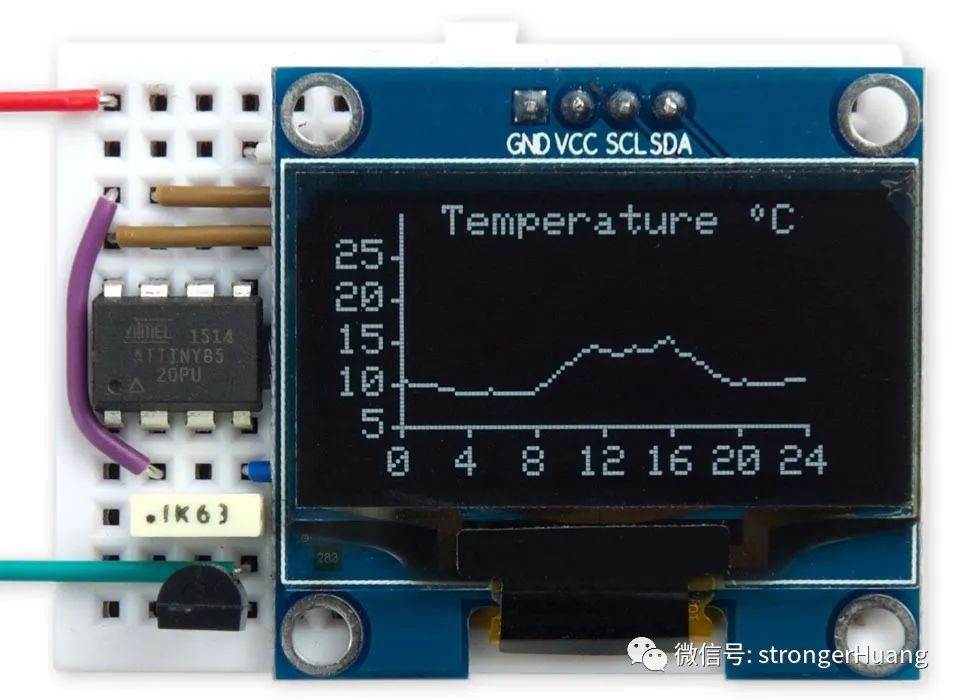
1、介绍
该128x64 OLED为单色显示屏,基于SSD1306驱动器芯片的OLED显示器。
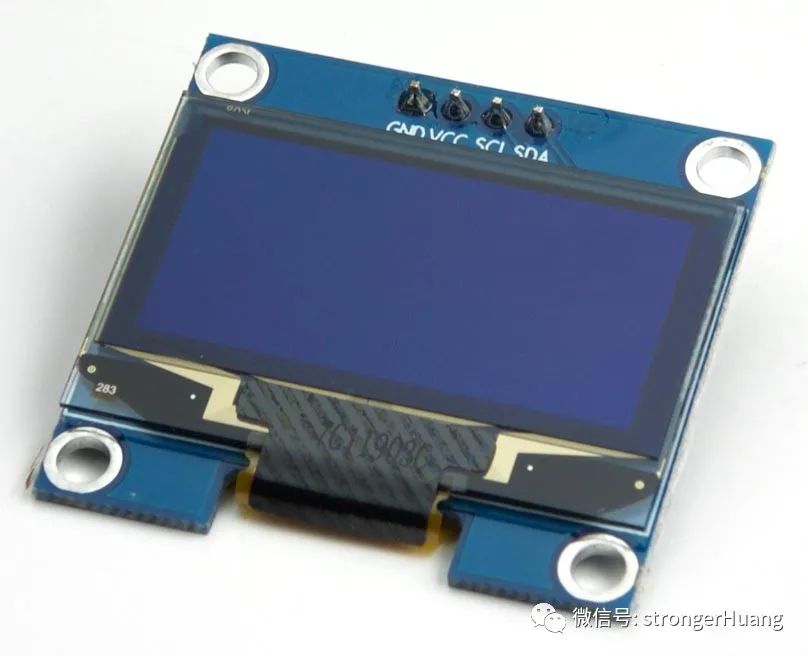
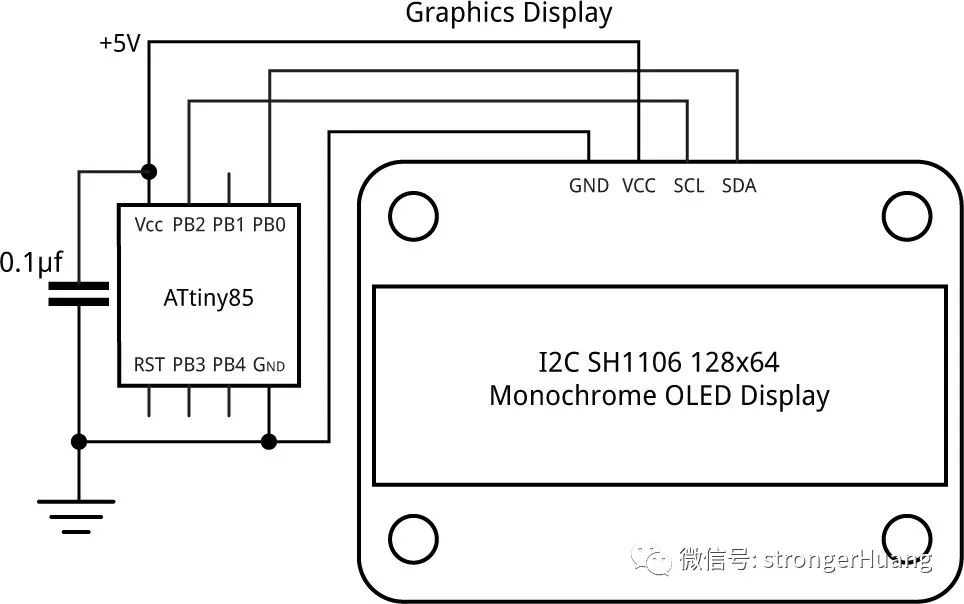
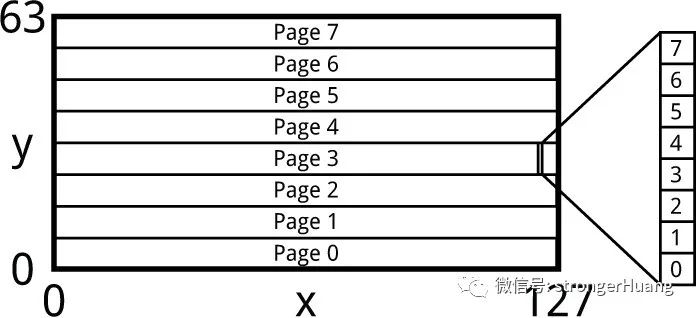
2、API接口说明
底层的通信和驱动,这里就不描述了,讲述主要的API接口:
ClearDisplay():清除显示。
InitDisplay():初始化显示。
PlotPoint(x,y):在(x,y)处绘制一个点。
MoveTo(x,y):将绘图位置移动到(x,y)。
DrawTo(x,y):从绘图位置到(x,y)画一条线。
PlotCharacter(c,x,y):绘制ASCII字符c,坐标为(x,y)。
PlotText(s):从当前绘图位置开始,绘制缓存中的文本字符串。
3、API源码
1.InitDisplay()初始化显示
1void InitDisplay () {
2 Wire.beginTransmission(address);
3 Wire.write(commands);
4 Wire.write(0xA1);
5 Wire.write(0xAF);
6 Wire.endTransmission();
7}
2.single()写命令
1void Single (uint8_t x) {
2 Wire.write(onecommand);
3 Wire.write(x);
4}
1void ClearDisplay () {
2 for (int p = 0 ; p < 8; p++) {
3 Wire.beginTransmission(address);
4 Single(0xB0 + p);
5 Wire.endTransmission();
6 for (int q = 0 ; q < 8; q++) {
7 Wire.beginTransmission(address);
8 Wire.write(data);
9 for (int i = 0 ; i < 20; i++) Wire.write(0);
10 Wire.endTransmission();
11 }
12 }
13}
1void PlotPoint (int x, int y) {
2 Wire.beginTransmission(address); //地址
3 Single(0x00 + ((x + 2) & 0x0F));
4 Single(0x10 + ((x + 2)>>4));
5 Single(0xB0 + (y >> 3));
6 Single(0xE0); //读取并修改写入
7 Wire.write(onedata);
8 Wire.endTransmission();
9 Wire.requestFrom(address, 2);
10 Wire.read();
11
12 int j = Wire.read();
13 Wire.beginTransmission(address);
14 Wire.write(onedata);
15 Wire.write((1<<(y & 0x07)) | j);
16 Single(0xEE); // Cancel read modify write
17 Wire.endTransmission();
18}
1void MoveTo (int x, int y) {
2 x0 = x;
3 y0 = y;
4}
1void DrawTo (int x, int y) {
2 int sx, sy, e2, err;
3 int dx = abs(x - x0);
4 int dy = abs(y - y0);
5 if (x0 < x) sx = 1; else sx = -1;
6 if (y0 < y) sy = 1; else sy = -1;
7 err = dx - dy;
8 for (;;) {
9 PlotPoint(x0, y0);
10 if (x0==x && y0==y) return;
11 e2 = err<<1;
12 if (e2 > -dy) { err = err - dy; x0 = x0 + sx; }
13 if (e2 < dx) { err = err + dx; y0 = y0 + sy; }
14 }
15}
1void PlotChar (int c, int x, int y) {
2 int h = y & 0x07;
3 for (int p = 0; p < 2; p++) {
4 Wire.beginTransmission(address);
5 Single(0xB0 + (y >> 3) + p); // Page
6 for (int col=0; col<6; col++) {
7 Single(0x00 + ((x+2+col) & 0x0F)); // Column low nibble
8 Single(0x10 + ((x+2+col)>>4)); // Column high nibble
9 Single(0xE0); // Read modify write
10 Wire.write(onedata);
11 Wire.endTransmission();
12 Wire.requestFrom(address, 2);
13 Wire.read(); // Dummy read
14 int j = Wire.read();
15 Wire.beginTransmission(address);
16 Wire.write(onedata);
17 int bits = ReverseByte(pgm_read_byte(&CharMap[c-32][col]));
18 Wire.write((bits<<h)>>(p<<3) | j);
19 Single(0xEE); // Cancel read modify write
20 }
21 Wire.endTransmission();
22 }
23}
1void PlotText(PGM_P s) {
2 int p = (int)s;
3 while (1) {
4 char c = pgm_read_byte(p++);
5 if (c == 0) return;
6 PlotChar(c, x0, y0);
7 x0 = x0 + 6;
8 }
9}
5、实例
1.说明
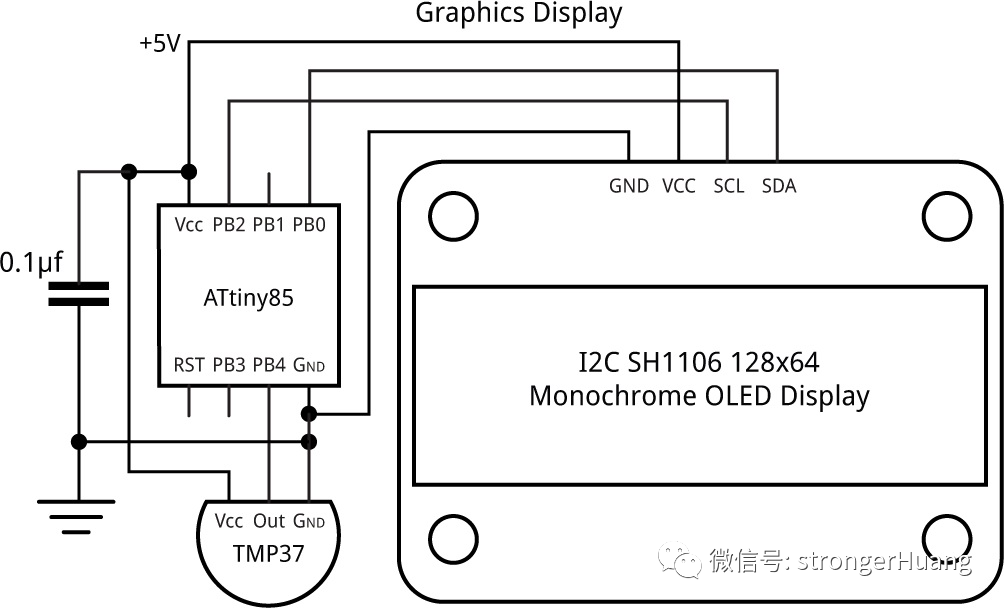
1const int Now = 1547; // 比如设置时间为:15:47
2unsigned long StartMins = (unsigned long)((Now/100)*60 + (Now%100));
3
4void loop () {
5 unsigned int SampleNo = StartMins/15;
6
7 // 绘制温度图
8 int x1 = 16, y1 = 11;
9 int yscale = 2;
10 MoveTo(26, 56); PlotText(PSTR("Temperature ~C"));
11
12 //横轴
13 MoveTo(x1, y1); DrawTo(x1+96, y1);
14 for (int i=0; i<=24; i=i+4) {
15 int mark = x1+i*4;
16 MoveTo(mark, y1); DrawTo(mark, y1-2);
17 int tens = i/10;
18 if (tens != 0) {
19 PlotChar(tens+'0', mark-6, y1-12);
20 PlotChar(i%10+'0', mark, y1-12);
21 } else PlotChar(i%10+'0', mark-3, y1-12);
22 }
23
24 //纵轴
25 MoveTo(x1, y1); DrawTo(x1, y1+50);
26 for (int i=5; i<=25; i=i+5) {
27 int mark = y1+i*yscale-10;
28 MoveTo(x1, mark); DrawTo(x1-2, mark);
29 int tens = i/10;
30 if (tens != 0) PlotChar(tens+'0', x1-15, mark-3);
31 PlotChar(i%10+'0', x1-9, mark-3);
32 }
33 for (;;) {
34 //每15分钟更新一下
35 while ((unsigned long) ((StartMins + millis()/60000)/15)%96 == SampleNo);
36 // Time to take a new reading
37 SampleNo = (SampleNo+1)%96;
38 int Temperature = (analogRead(A2)*25)/233;
39 PlotPoint(SampleNo+x1, Temperature-10+y1);
40 }
41}
小哥搜集了一些嵌入式学习资料,公众号内回复【1024】即可找到下载链接!
推荐好文 点击蓝色字体即可跳转







文章转载自嵌入式情报局,如果涉嫌侵权,请发送邮件至:contact@modb.pro进行举报,并提供相关证据,一经查实,墨天轮将立刻删除相关内容。






